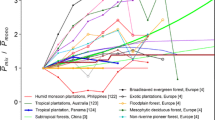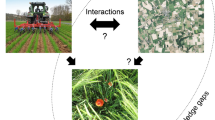Abstract
Old World Bluestems (OWB), introduced from Europe and Asia in the 1920s, recently have begun to raise concerns in the Great Plains. Despite suggestion in the late 1950s that OWB were weedy and negatively impacted biological diversity, they were widely introduced throughout the Great Plains for agricultural purposes. Anecdotal evidence suggests that OWB exhibit invasive characteristics that promote competitive exclusion of native species. The objective of our study was to quantify the competitive abilities of two OWB species (Caucasian bluestem; Bothriochloa bladhii (Retz.) S.T. Blake (= Bothriochloa caucasica (Trin.) C.E. Hubb.) and yellow bluestem; Bothriochloa ischaemum (L.) Keng) with three native grass species (big bluestem (Andropogon gerardii Vitman), little bluestem (Schizachyrium scoparium (Michx.) Nash), and sideoats grama (Bouteloua curtipendula (Michx.) Torr.)). A greenhouse target-neighbor study was conducted to assess both interspecific and intraspecific competition. A total of 480 pots (4.4 l) filled with native soil was used with all pair-wise combinations of species and four density treatments (six replications). Vegetative tiller height, above- and belowground biomass were measured at the end of 16 weeks. Both of the OWB significantly inhibited at least one growth parameter of the three native grass species, while most of the native species did not inhibit growth of either OWB species. Growth of B. ischaemum was enhanced when grown in association with S. scoparium. Based upon the results of our study of OWB competitive superiority and previous research, many of the characteristics possessed by OWB are found to be in common with known invasive species. Hence, we propose that two OWB are competitively superior to three common native prairie species providing them with the ability to invade and threaten the native grasslands of the Central and Southern Great Plains.


Similar content being viewed by others
References
Anderson V, Briske D (1995) Herbivore-induced species replacement in grasslands: is it driven by herbivory tolerance or avoidance? Ecol Appl 5:1014–1024
Baker H (1965) Characteristics and modes of origin of weeds. In: Baker H, Stebbins G (eds) The genetics of colonizing species. Academic Press, New York
Baker H (1974) The evolution of weeds. Annu Rev of Ecol and Syst 5:1–24
Berg W, Sims P (1984) Herbage yields and water-use efficiency on a loamy site as affected by tillage, mulch, and seeding treatments. J Range Manage 37:180–184
Berlow E (1997) From canalization to contingency: historical effects in a successional rocky intertidal community. Ecol Monograph 67:435–460
Blossey B (1999) Before, during and after: the need for long-term monitoring in invasive plant species management. Biol Invasions 1:301–311
Blossey B, Nötzold R (1995) Evolution of increased competitive ability in invasive nonindigenous plants: a hypothesis. J Ecol 83:887–889
Briske D (1991) Developmental morphology and physiology of grasses. In: Heitschmidt R, Smith J (eds) Grazing management an ecological perspective. Timber Press, Portland
Busch D, Smith S (1995) Mechanisms associated with decline of woody species in riparian ecosystems of the Southwestern U.S. Ecol Monographs 65:347–370
Celarier R, Harlan J (1955) Studies on old world bluestems. Okla Agric Exp Stn Bull T-58
Connell J (1983) On the prevalence and relative importance of interspecific competition: evidence from field experiments. Amer Nat 122:661–696
Coyne P, Bradford J (1985a) Some growth characteristics of four Old World bluestems. J Range Manage 38:27–33
Coyne P, Bradford J (1985b) Morphology and growth in seedlings of several C4, perennial grasses. J Range Manage 38:504–512
Crawley M (1987) What makes a community invasible? In: Gray A, Crawley M, Edwards P (eds) Colonization, succession and stability. Blackwell Scientific Publications, London
D’Antonio C, Hughes R, Vitousek P (2001) Factors influencing dynamics of two invasive C4 grasses in seasonally dry Hawaiian woodlands. Ecology 82:89–104
D’Antonio C, Mahall B (1991) Root profiles and competition between the invasive, exotic perennial, Carpobrotus edulis, and two native shrub species in California coastal scrub. Am J Bot 78:885–894
D’Antonio C, Vitousek P (1992) Biological invasions by exotic grasses, the grass/fire cycle, and global change. Annu Rev Ecol Syst 23:63–87
Eagles C (1972) Competition for light and nutrients between natural populations of Dactylis glomerata. J Appl Ecol 9:141–151
Eck H, Sims P (1984) Grass species adaptability in the southern High Plains – a 36 year assessment. J Range Manage 37:211–217
Fowler N (1982) Competition and coexistence in a North Carolina grassland. J Ecol 70:77–92
Freckleton R, Watkinson A (2000) Designs for greenhouse studies of interactions between plants: an analytical perspective. J Ecol 88:386–391
Goldberg D, Fleetwood L (1987) Competitive effect and response in four annual plants. J Ecol 75:1131–1143
Goldberg D, Landa K (1991) Competitive effect and response: hierarchies and correlated traits in the early stages of competition. J Ecol 79:1013–1030
Gould A, Gorchov D (2000) Effects of the exotic invasive shrub Lonicera maackii on the survival and fecundity of three species of native annuals. Amer Mid Nat 144:36–50
Grace J, Smith M, Grace S et al. (2002) Interactions between fire and invasive plants in temperate grasslands of North America. In: Galley K, Wilson T (eds) Proceedings of the invasive species workshop: the role of fire in the control and spread of invasive species. Fire conference 2000: the First National Congress on Fire Ecology, Prevention, and Management. Miscellaneous Publication No. 11, Tall Timbers Research Station, Tallahassee
Harlen J, Celarier R, Richardson W et al (1958) Studies on Old World Bluestem II. Okla Agric Exp Stn Bull T-72
Hartnett D, Hetrick B, Wilson G et al (1993) Mycorrhizal influence on intra- and interspecific neighbor interactions among co-occurring prairie grasses. J Ecol 81:787–795
Harmoney K, Hickman K (2004) Comparative morphology of caucasian old world bluestem (Bothriochloa bladhii) and native grasses. Agron J 96:1540–1544
Hickman K, Farley G, Channell R et al (2006) Effects of old world bluestem (Bothriochloa ischaemum) on food availability and avian community composition within the mixed-grass prairie. Southwestern Assoc Nat 51:524–530
Hoekstra J, Boucher T, Ricketts T et al (2005) Confronting a biome crisis: global disparities of habitat loss and protection. Ecol Lett 8:23–29
Lonsdale W (1999) Global patterns of plant invasions and the concept of invasibility. Ecology 80:1522–1536
Mack R (1996) Predicting the identity and fate of plant invaders: emergent and emerging approaches. Biol Cons 78:107–121
Mack R, Harper J (1977) Interference in dune annuals: spatial pattern and neighbourhood effects. J Ecol 65:345–363
Newsome A, Noble I (1986) Ecological and physiological characters of invading species. In: Groves R, Burdon J (eds) Ecology of biological invasions. Cambridge University Press, Cambridge
Reed H, Seastedt T, Blair J (2005) Ecological consequences of C4 grass invasion of a C4 grassland: a dilemma for management. Ecol Appl 15:1560–1569
Sakai A, Allendorf F, Holt J et al (2001) The population biology of invasive species. Annu Rev Ecol Syst 32:305–32
Sammon J, Wilkins K (2005) Effects of an invasive grass (Bothriochloa ischaemum) on a grassland rodent community. Tex J Sci 57:371–383
Samson F, Knopf F (1994) Prairie conservation in North America. Bioscience 44:418–421
Schmidt C, Hickman K (2006) Stolon production by caucasian bluestem (Bothriochloa bladhii). Trans Kansas Acad Sci 109:74–76
Silander J, Pacala S (1985) Neighborhood predictors of plant performance. Oecol 66:256–263
Smith M, Knapp A (1999) Exotic plant species in a C4-dominated grassland: invisibility, disturbance, and community structure. Oecol 120:605–612
Stastny M, Schaffner U, Elle E (2005) Do vigour of introduced populations and escape from specialist herbivores contribute to invasiveness? J Ecol 93:27–37
Szente K, Nagy Z, Tuba Z et al (1996) Photosynthesis of Festuca rupicola and Bothriochloa ischaemum under degradation and cutting pressure in a semiarid loess grassland. Photosynthetica 32:399–407
Tilman D (1987) The importance of the mechanisms of interspecific competition. Amer Nat 129:769–774
Tilman D (1997) Community invasibility, recruitment limitation, and grassland biodiversity. Ecology 78:81–92
Tomanek G (1963) Pasture and range plants. Fort Hays State University, Hays
Tremmel D, Bazzaz F (1993) How neighbor canopy architecture affects target plant performance. Ecology 74:2114–2124
Turner T (1985) Stability of rocky intertidal surfgrass beds: persistence, preemption, and recovery. Ecology 66:83–92
Vilà M, Weiner J (2004) Are invasive plant species better competitors than native plant species? – evidence from pair-wise experiments. Oikos 105:229–238
Weaver J (1931) Who’s who among the prairie grasses. Ecology 11:455–621
Weiner J (1982) A neighborhood model of annual-plant interference. Ecology 63:1237–1241
Weiner J (1986) How competition for light and nutrients affects size variability in Ipomoea tricolor populations. Ecology 67:1425–1427
Weiner J (1990) Asymmetric competition in plant populations. Trends Ecol Evolut 5:360–364
Willis A, Memmott J, Forrester R (2000) Is there evidence for the post-invasion evolution of increased size among invasive plant species? Ecology Lett 3:275–283
Zar J (1999) Biostatistical analysis. 4th edn. Prentice-Hall, Upper Saddle River
Acknowledgments
We would like to thank USDA-NRCS Plant Material Center, Manhattan, Rich Wynia, Sharp Brothers Seed Company, and Johnston Seed Company for donation of native and non-native seeds. Comanche Pool Prairie Resource Foundation for funding. FHSU Grounds Department and Department of Biological Sciences for delivery, and removal of soil, and use of the greenhouse. Thank you to the greenhouse crew; Rachel Copeland-Knight, Amy Hladek, Regina Green, Mindy Scheck, John Moyer, David Bender, Matt Withroder, and David, Linda, and Marla Schmidt. Authors also wish to thank Gail Wilson, OSU Natural Resource Ecology and Management Department for her detailed review of the manuscript, and two anonymous reviewers for their insightful comments.
Author information
Authors and Affiliations
Corresponding author
Rights and permissions
About this article
Cite this article
Schmidt, C.D., Hickman, K.R., Channell, R. et al. Competitive abilities of native grasses and non-native (Bothriochloa spp.) grasses. Plant Ecol 197, 69–80 (2008). https://doi.org/10.1007/s11258-007-9361-2
Received:
Accepted:
Published:
Issue Date:
DOI: https://doi.org/10.1007/s11258-007-9361-2




